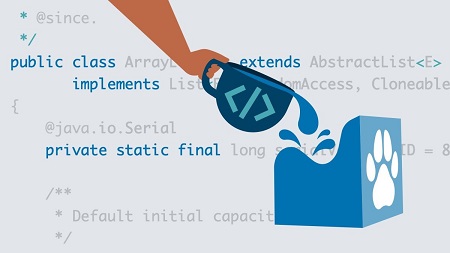
English | MP4 | AVC 1280×720 | AAC 48KHz 2ch | 1h 59m | 363 GB
Are you familiar with Java but want to get the most out of your Java programs? In this course, Kathryn Hodge teaches the basics of object-oriented programming in Java, so you can write code that’s secure, scalable, and easier to troubleshoot. Kathryn begins by showing how object-oriented principles are embedded into the Java language from the first code file you create. She looks at how classes, instances, and constructors embody the idea of representing real-life objects in code. Kathryn not only shows how to apply object-oriented principles in your own programs, but also explains how Java leverages these principles behind the scenes. While many resources about object-oriented programming focus on abstract examples, the goal of this course is to get away from the abstract and focus more on practical examples of these principles in Java. Along with deep dives into the source code, this course also provides several challenges and solutions to help you apply what you’ve learned.
Table of Contents
Introduction
1 Why learn about object-oriented programming in Java
2 What is object orientation
1. Classes and Objects in Java
3 Using classes as blueprints
4 Building objects with a constructor
5 Using concrete instances for application logic
6 Understanding the difference between class and instance members
7 Exploring a built-in Java class
8 Challenge Build an employee class
9 Solution Build an employee class
2. Encapsulation in Java
10 What is encapsulation
11 Discovering access modifiers
12 Implementing encapsulation with access modifiers
13 Exploring encapsulation in Java string class
14 Challenge Banking application
15 Solution Banking application
3. Inheritance in Java
16 What is inheritance
17 Leveraging different types of inheritance
18 Using inheritance to reduce code duplication
19 Discovering inheritance in foundational Java classes
20 Challenge Reduce redundant code with inheritance
21 Solution Reduce redundant code with inheritance
4. Polymorphism in Java
22 What is polymorphism
23 Writing reusable algorithms with runtime polymorphism
24 Exploring different forms in a single object
25 Accessing specific object forms with instanceof
26 Writing flexible code with compile-time polymorphism
27 Exploring how built-in Java classes use polymorphism
28 Challenge Reduce complexity with polymorphism
29 Solution Reduce complexity with polymorphism
5. Abstraction in Java
30 What is abstraction
31 Using abstract classes in Java to reduce code complexity
32 Using interfaces in Java to provide conformity
33 Discovering abstraction in Java source code
34 Challenge Leverage abstraction to write simpler applications
35 Solution Leverage abstraction to write simpler applications
Conclusion
36 Next steps
Resolve the captcha to access the links!